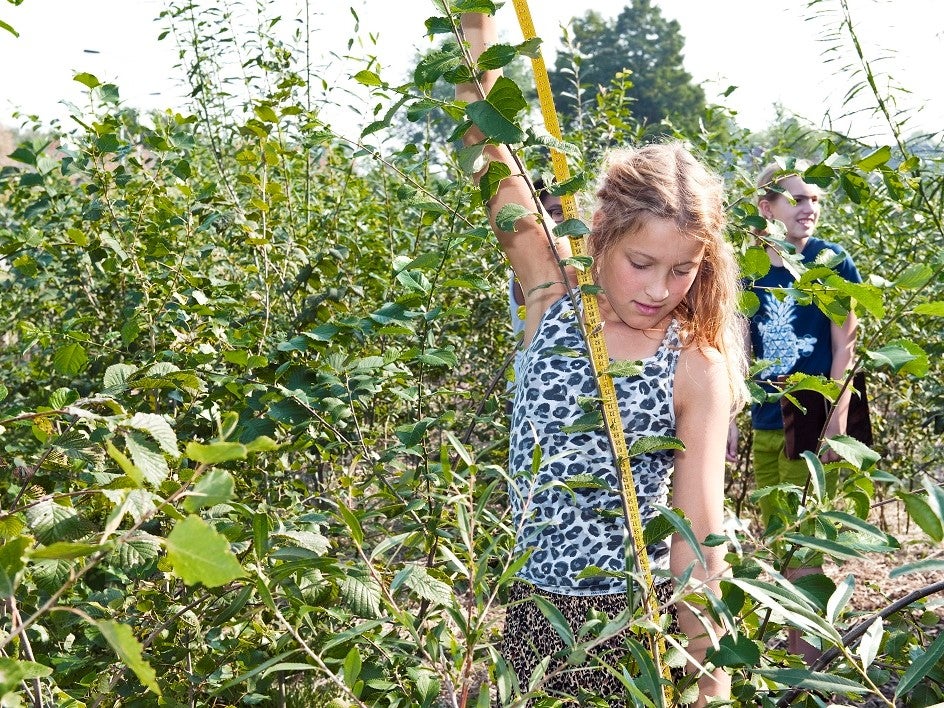‘Mini but mighty’: Inside the scheme to plant 150 tiny forests in UK cities in bid to aid climate
Some 600 trees will be packed into areas no bigger than tennis courts – with advocates saying the super-plots will mitigate flooding, improve urban biodiversity and boost mental health. Colin Drury examines the ‘Tiny Forest’ phenomenon that’s set to take our towns and cities by storm


It is a small plot of green land, no bigger than a tennis court and in the middle of an Oxfordshire housing estate, which an untrained observer might not give a second glance.
But this innocuous little patch of Witney close to the A40 may, it seems, be the unlikely birthplace of an environmental revolution set to transform neighbourhoods across the UK, including in London, Glasgow and Birmingham, from this year on. Albeit, in a very mini way.
Some 600 saplings have been tightly planted at this council-owned site for what will become the country’s first ever Tiny Forest.
What’s one of those?
A super-small but super-dense and super-biodiverse piece of urban woodland which, advocates say, can help fight climate change, mitigate neighbourhood flooding, bring more wildlife into the built-up environment and, just for good measure, boost the mental wellbeing of people living and working nearby.
The trees in this Witney pilot will grow up to 25 metres tall and become so closely packed together that, eventually, sunlight will not hit the ground beneath them. Within the interconnecting – and impenetrable – leaves, branches and roots, an estimated 500 different species of insects, birds and small mammals will make their home. When it rains, the whole thing will be capable of absorbing 30,000 litres of water. So thick will the canopy be that hardly any liquid will make it onto the ground below.
Crucially, the sheer concentration of the trees will make them especially efficient at sucking carbon from the atmosphere, it is believed. The exact effects on pollution levels have not yet been quantified but experts suggest the plot will act as a massive air purifier for the surrounding streets.
All of this from a patch of land no bigger than a tennis court.
“The aim is it becomes a block of wild nature in the middle of town,” says Beth Pudifoot, research assistant with Earthwatch, the non-profit conservation organisation behind the project. “And it comes with all the benefits you would expect from that.”
Now, following this first scheme, the organisation is aiming to plant another 150 such Tiny Forests across the UK by 2023, with specific plans for at least 25 this year, including in Bristol, Manchester and Leicester. Three sites will be transformed in January alone – pandemic notwithstanding – in Oxford, London and Jersey.
In each one, small pathways through the tangle will be developed, while, in some, small learning spaces and benches will be installed amid the undergrowth. But mainly, they will be left as bite-sized chunks of wild habitat to be observed rather than entered. Human maintenance will be minimal after the first five years, so the theory goes.
“They will just be great resource for communities,” says Pudifoot. “In the grand scheme of things, of course these are small areas and a small number of trees – certainly on their own they won’t make a city carbon neutral or anything like that. But it is the variety of the benefits that Tiny Forests create from such a small space that can really make them really invaluable assets.
“Trees provide so many services so [when you have them densely packed together] that makes those services especially efficient, whether that’s in flood mitigation, carbon capture, improving biodiversity or offering a place for science research and education.”
Tiny Forests may be new to the UK but their origins actually date back to the Seventies.
It was then that Japanese botanist Dr Akira Miyawaki came up with a simple – now proven – theory that, by planting native saplings in especially dense concentrations, it stimulates both speedy growth (by creating competition) and extra strength (by effectively providing group protection against external threats).
Since then, some 40 million trees have been planted across 15 countries in this way. Miyawaki, himself now 91, was given the Blue Planet Prize in 2006 for his contribution to solving global environmental problems. If you ever visit Japan’s tsunami buffer zones, the coastal forests there – planted in a bid to reduce the impact of any future inundation – tend to have been designed in accordance to his methods.
But it was in 2015 that his ideas were adapted – or rather down-sized – by Dutch conservationists, who came up with Tiny Forests. Experts with the country’s IVN Nature Education organisation took Miyawaki’s dense planting and applied it to, well, tiny spaces, generally in urban settings.
In the intervening five years, they have created more than 100 of them in the Netherlands – including in Utrecht and Zaandaam – and have advised on schemes in France and Belgium. Now, they are helping with the UK projects.
“Tree planting schemes have had a lot of traction recently, but most of these schemes are not necessarily compatible with urban areas,” said Victor Beumer, the Dutch conservationist who first introduced IVN’s work to Earthwatch, when he spoke during the Witney planting in March. “Tiny Forests, on the other hand, provide an ideal solution for urban areas as a way to maximise the benefits trees can offer in a small space and where land can be limited.”
Plots which will be transformed in Britain will include council property, urban school grounds and private space, with planting generally done by Earthwatch staff, local volunteers and partner organisations such as nearby schools. Specific sites have not been revealed as yet but each one forest costs up to £25,000 with the money coming from sponsors, partners or local authorities.
Not everyone is a fan, it should be said.
Some question if tennis court-sized patches of dark and impenetrable trees in the middle of a city might attract both anti-social behaviour and pests such as foxes.
But back in Witney, town councillor Duncan Enright – who was mayor when the plot, in the town’s Eton Close, was planted – says nearby residents has been hugely positive about the creation.
“It’s an excellent thing – and to be the first in the UK was fantastic,” he says. “The town council aims to be carbon neutral by 2028 and this was both a symbolic and practical step to achieving that.”
While the forest is still in its earliest days, he adds, the benefits are already beginning to manifest themselves.
“Tiny but mighty describes it,” he says. “In the summer, when it was only a few months old, we were already seeing birds, bees and butterflies thriving there so the future is exciting. Several other councils have already been in touch about it and our advice is always the same: go for it. I think it will really be something that takes off. The benefits are too big to ignore.”


Join our commenting forum
Join thought-provoking conversations, follow other Independent readers and see their replies
Comments